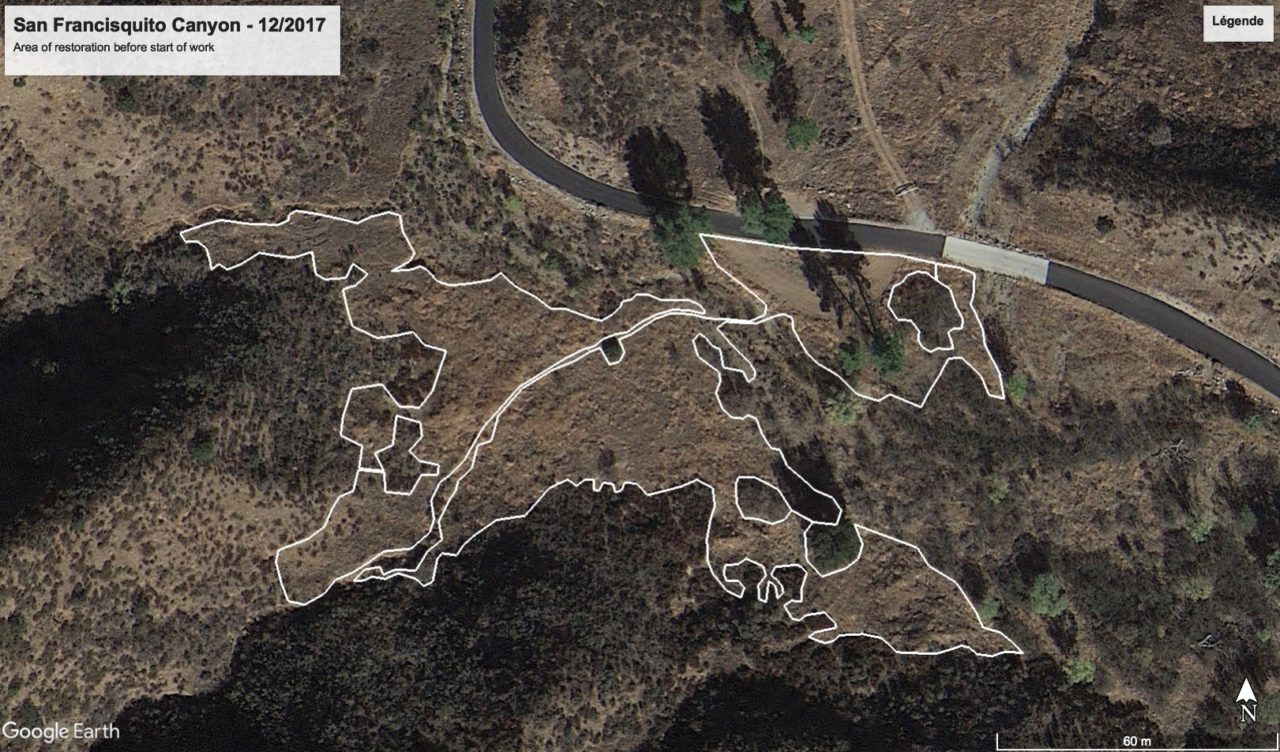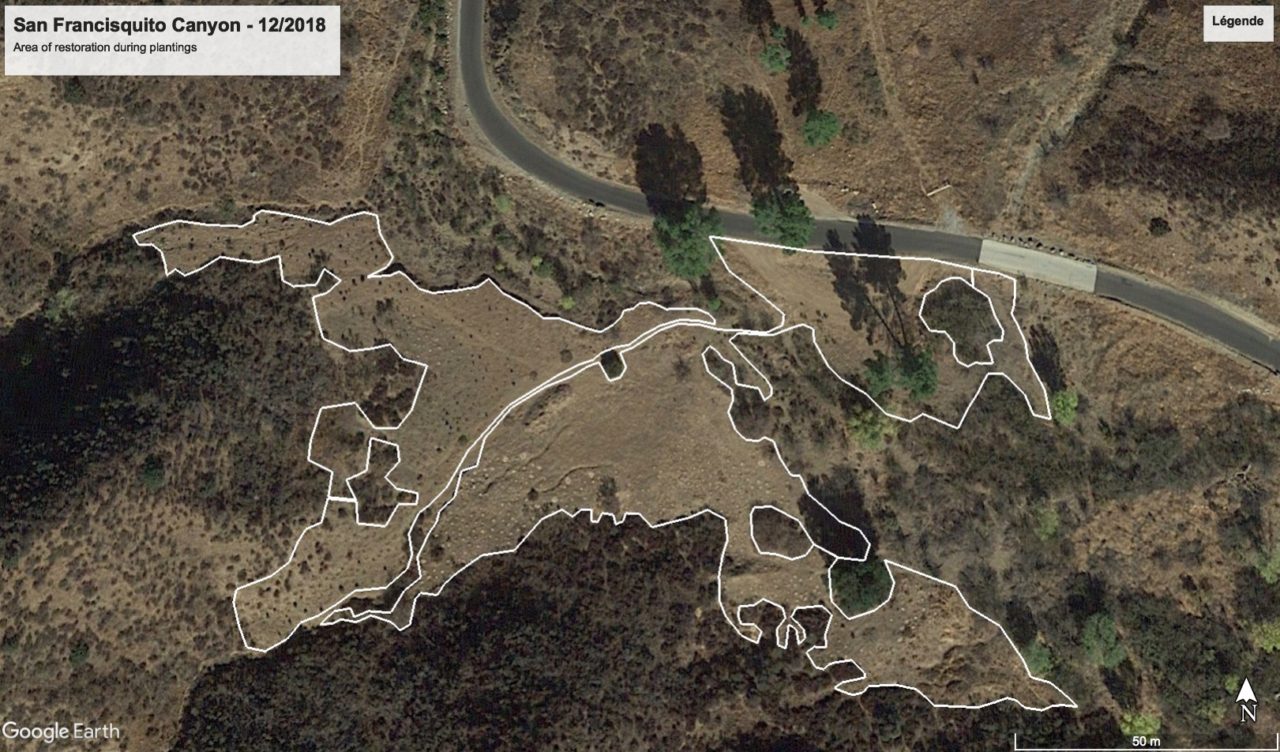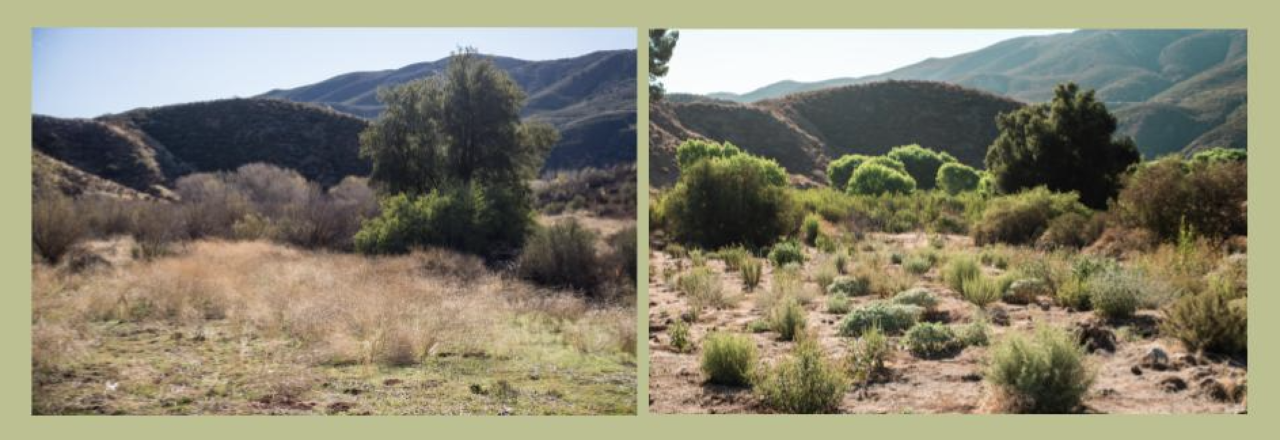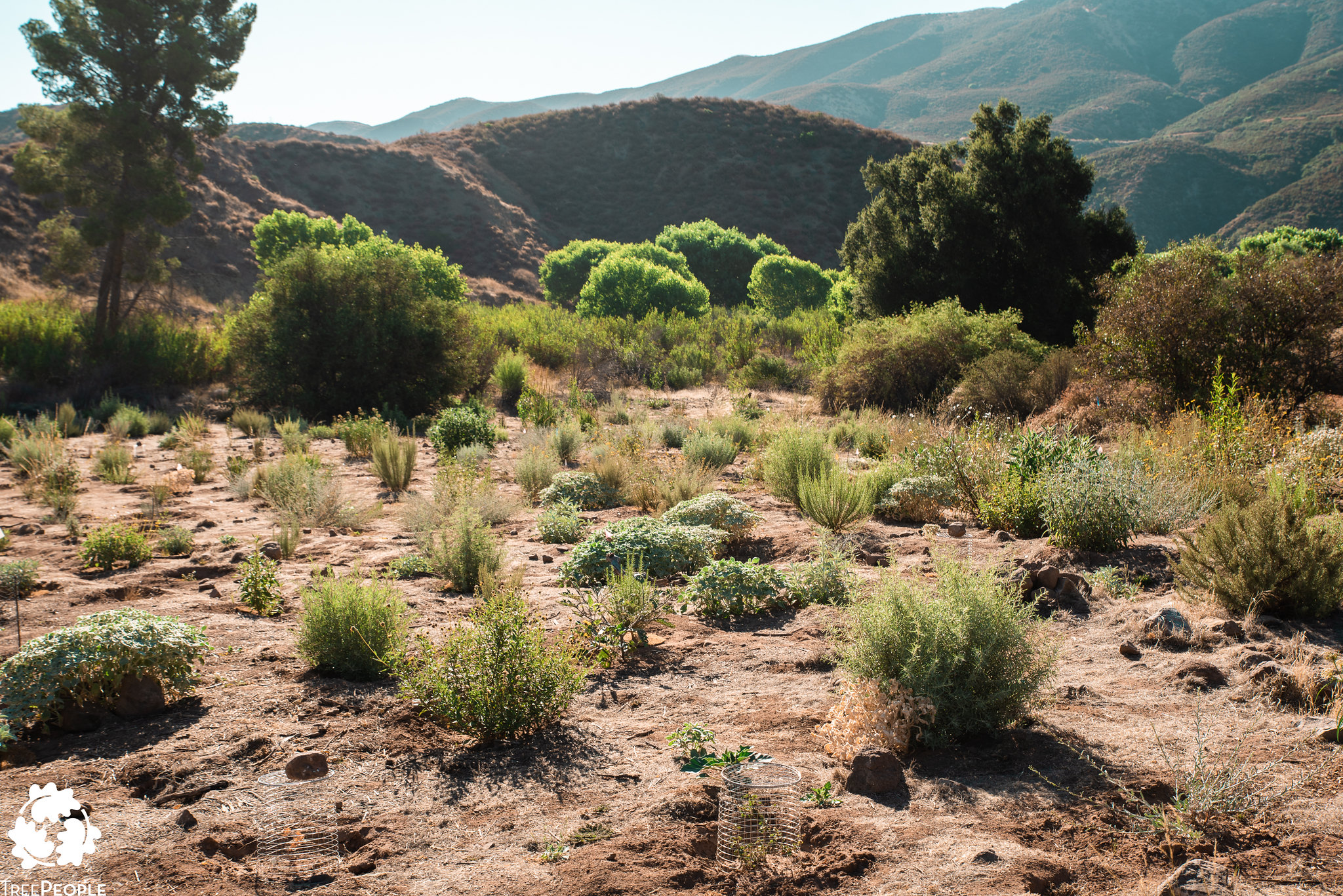Since March 2018, TreePeople has been restoring a fire-damaged area of San Francisquito Canyon in the Angeles National Forest. The work is funded by a grant administered by the National Fish and Wildlife Foundation, from the money awarded to the USDA following the lawsuit brought against the construction companies responsible for the 2002 Copper Fire.
The work started by the removal of many invasive plants which had taken over several areas adjacent to a creek feeding into the Santa Clara River. The invasive plant’s competition led to the conversion of a once-beautiful chaparral landscape into a very thick mix of various non-native grasses, clover and mustard (Hirschfeldia incana, Centaurea melitensis, Erodium cicutarium, Medicago polymorpha, Melilotus indicus, Nicotiana glauca, Bromus diandrus, Bromus madritensis, Bromus hordeauceus, Avena fatua, Piptatherum miliaceum).

The two-acre site was selected in agreement with the US Forest Service for its significant relevance to the local watershed and its accessibility to volunteers.
We knew that restoring the chaparral habitat would not only bring back the natural wildlife diversity of both plants and animals but would also limit the danger of fire through the removal of considerable amounts of flash fuel generated by the various invasive plants. These plants dry out by the end of spring and remain in that state until the next season.
Re-installing native trees, shrubs, and grasses would help bring back a functioning watershed. Therefore, rainfall is absorbed in the soil and trickles down to the wash, creek, and river, expanding the very much needed local water source while limiting the possibility of mudslides.
However, the project is not only geared towards restoring the land. As a volunteer-based organization, TreePeople has been engaging the local community (Santa Clarita, Newhall, Green Valley, etc.) to come and support the work by attending weekly restoration events. Over the 18 months of the project so far, 2,200 people have participated in more than 100 events.

Middle and high school students, college classes, families, partnering organizations, and individual volunteers have contributed over 9,500 hours of work. Not only did they each help with the actual work, but they also learned the basic elements of ecosystem restoration such as: its importance for the local mountains and community, some of the differences between non-native and native plants, and the various ways the plants interact with the local wildlife.
Additionally, 34 volunteers took our Wildland Restoration Supervisor Training. Training allows them to become proficient in TreePeople’s management practices, then help further organize and run restoration events.
Between March 2018 and April 2019, volunteers pulled and removed from the site over 60 cubic yards of non-native invasive plants. They also planted 2,965 native perennial plants from about 40 different species, grown by the Rancho Santa Ana Botanic Garden nursery from seeds collected in nearby appropriate areas of the Angeles National Forest. The plantings were then watered about once a month during the dry season to help them establish their root system for the first year.

In the coming fall, TreePeople’s staff and volunteers will continue the maintenance of the current site. Restoration typically requires limited maintenance from 2 to 5 years after the start.
The work will also expand from the original 2.5 acre-site to another couple of adjacent sites totaling about 5/6 acres of restored land. The plants and seedlings needed for future plantings will be provided by the newly updated TreePeople nursery. Having put in place the Best Management Practices to ensure a “Phytophthora-free” environment, this is one out of only two nurseries in Southern California qualified for this kind of work for the US Forest Service.
With the heavy rain season of this past winter and spring, the restoration site got both a big positive boost and some additional obstacles. On the one hand, the unusually longer and wetter winter supported an extraordinary growth of non-native species.
Invasive plants grew in bigger numbers and size, as the plants competed for light being sustained by the extra moisture. The larger plant roots, higher soil moisture, and fertility required multiple rounds of invasive removal.
On the other hand, the abundance of moisture has helped the planted native perennial seedlings establish a healthy root system, and grow large. Some plants are now over 8 feet tall, some 10 feet wide. Most, if not all, species have gone to seed, further confirming and multiplying the success of the project. Indeed, these new native seeds have multiplied and the site is now filling with hundreds of additional “volunteer,” naturally regenerated plants.
In addition, the seeds of annual native plants which were collected in 2018 and broadcast at the site have successfully germinated in the spring of 2019 to produced a large “crop” of Amsinckia intermedia (fiddleneck), Lupinus bicolor (dove lupine), Croton Setiger (doveweed), Heterotheca grandiflora (telegraph weed) and many others. Other plants species, which were not even present at the onset of the project, have now made their way back in.

Other positive outcomes have to do with a renewed presence of wildlife. From rabbit and deer grazing on the perennial grasses to the various species of pollinators exploring the wide range of flowers – including our State’s Monarch butterfly finding its way in the newly blooming milkweed.
Volunteers who participated in our early events sometimes have a hard time believing how much the site has changed over the course of a year and a half. They find it especially rewarding and inspiring to be part of a project that has brought so much positive change to this area of the Angeles National Forest.
Once our volunteers become team leaders (Volunteer Supervisors), some of them show up regularly, sometimes almost every week. Mary, who is a Santa Clarita school teacher, attended 40 events since July 2018. This past July, she chose to spend her holidays as one of our interns to help perform surveys of all planted areas as well as collecting seeds. Cami and Hannah, while studying at UCLA attended a combination of 52 events, and both became interns with the program. In February 2019, Hannah joined TreePeople’s staff as Angeles Restoration Coordinator. And there are many others who have attended multiple events: Ashley, Chase, Clayton, James, Jimmie, Leon, Manuel, Matt, Paul, Stephanie, Talisa, Walt, Wade, etc. Their dedication and enthusiasm are a big part of this restoration program’s success.
The restoration of San Francisquito Canyon is conducted in partnership with the US Forest Service, and funded by the National Fish and Wildlife Foundation. Other partners include the Santa Clarita Valley Water Agency who provides the water for plantings and waterings, Rancho Santa Ana Botanic Garden, who provide almost 3,000 native grasses, shrubs, and trees.

